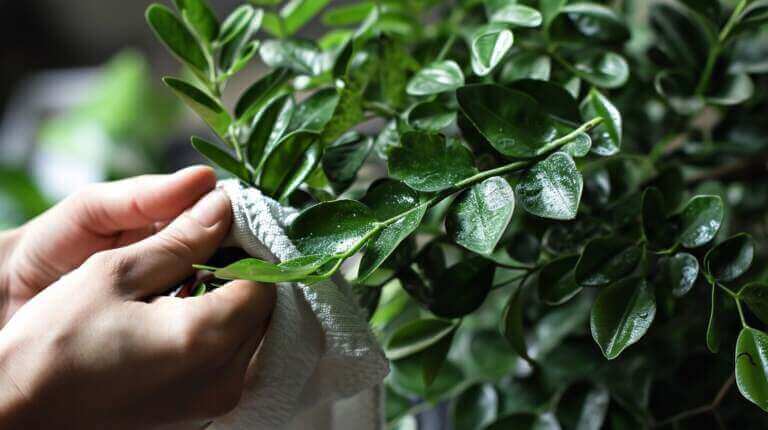How to Propagate Elephant Ear Plant: Propagation Methods to Grow New Plants
Growing an elephant ear plant is a delightful experience, but did you know you can propagate them and expand your collection? There are several methods you can use to propagate elephant ear plants, such as dividing the tubers and planting them in separate containers. By following these techniques, you can successfully propagate your elephant ear plant and create a thriving garden. Let’s explore the different propagation methods and how to get started!
Key Takeaways:
- Propagating an elephant ear plant allows you to grow new plants and expand your collection.
- Methods of propagation include dividing the tubers and planting them in separate containers.
- It’s best to dig up the parent plant in the fall when it starts to go dormant.
- Gently untangle the new tubers from the parent plant’s roots and use a sharp knife to cut them away.
- Plant the tubers indoors or outdoors, depending on the season and desired growth location.
When and How to Dig Up the Parent Plant
In order to propagate an elephant ear plant, it is important to know when and how to dig up the parent plant. The ideal time to do this is in the fall when the plant starts to go dormant. By digging up the parent plant during this time, you can reduce stress on the plant and increase the chances of successfully separating the new tubers without causing harm.
If the elephant ear plant is potted, carefully lift it out by grabbing onto the stems. Be gentle to avoid damaging the plant. If the plant is in the ground, use your hands or a shovel to dig around the plant and loosen the soil. Once the soil is loosened, lift the plant out, making sure to shake off any excess soil. This will allow you to examine the tubers and select healthy ones with roots for propagation.
By following these steps, you can ensure that your parent plant remains healthy and that you have a successful propagation process. Digging up the parent plant at the right time and with the proper technique is key to expanding your elephant ear plant collection.
| Benefits of Fall Propagation | Benefits of Dividing New Tubers | Benefits of Separating Tubers |
|---|---|---|
| Reduces stress on the parent plant | Allows for easier management and handling | Allows for more precise selection of healthy tubers |
| Increases chances of successful separation | Promotes healthy growth of new plants | Avoids spreading diseases or pests |
Propagation by Dividing New Tubers
Propagation by dividing new tubers is one of the most common and effective methods to propagate elephant ear plants. This technique involves separating the new growth tubers from the parent plant and planting them individually to establish new plants. Dividing the tubers allows each plant to have its own root system and nutrients, promoting optimal growth and development.
Tuber Separation
To propagate elephant ear plants by dividing new tubers, start by gently untangling the new tuber’s roots from the parent plant’s roots. Using a clean and sharp knife, carefully cut the new tubers away from the main plant wherever they intersect. Ensure that each new tuber has its own set of roots attached.
It’s important to note that elephant ear tubers have a potato-like texture, making them easy to slice through. However, always exercise caution to prevent injuries. Remember to clean the knife between each cut to prevent the transmission of diseases between the plants.
Number of Tubers to Divide
When dividing new tubers, you can choose to cut all of the new growth tubers away from the main plant mass or leave some attached. Cutting all the new growth tubers will result in separate individual plants. Leaving some attached will allow the parent plant to grow larger more quickly, as it can continue to draw nutrients from the connected tubers.
It’s recommended to assess the size and health of the parent plant before deciding how many tubers to divide. If the parent plant is already large and established, dividing all the new growth tubers will ensure the best chance of successful propagation and the development of healthy individual plants.
Propagation by Planting Tubers Indoors
If you want to grow your new elephant ear plants immediately, you can plant the tubers indoors. Select a large pot with drainage holes and fill it with well-draining potting soil. Make a well in the soil slightly larger than the tuber and place it in the well with the pointy side facing up. Lightly pack the soil around the tuber and water it gently. A mixture of peat moss and sand is suitable for growing elephant ear plants. Keep the potted tubers in a cool, dark place until spring, maintaining a temperature of 50 to 60°F.
If you prefer growing your elephant ear plants indoors, make sure to provide them with sufficient sunlight. Place them near a south-facing window or use artificial grow lights to meet their lighting requirements. Keep the soil moist but not waterlogged, watering the plant when the top inch of soil feels dry. Fertilize the plants every two weeks with a balanced liquid fertilizer to promote healthy growth.
Tips for Indoor Elephant Ear Propagation
- Choose a large pot with drainage holes to ensure proper water drainage and prevent waterlogging.
- Place the tuber in the pot with the pointy side facing up, covering it with well-draining potting soil.
- Maintain a temperature of 50 to 60°F and a humidity level of around 50% for optimal growth.
- Water the plant regularly, keeping the soil moist but not waterlogged.
- Provide sufficient sunlight by placing the plant near a south-facing window or using artificial grow lights.
- Fertilize the plant every two weeks with a balanced liquid fertilizer to promote healthy growth.
| Indoor Elephant Ear Propagation | Propagation Method | Growing Conditions |
|---|---|---|
| Planting Tubers Indoors | Select healthy tubers and plant them in well-draining potting soil. | Maintain a temperature of 50 to 60°F, provide sufficient sunlight, and water regularly. |
| Dividing New Tubers | Cut new tubers from the parent plant and plant them individually. | Plant in well-draining soil, provide adequate sunlight, and water regularly. |
| Planting Tubers Outdoors | Plant tubers directly in the ground in a sunny location. | Ensure the soil temperature is at least 65°F and water regularly. |
Propagation by Planting Tubers Outdoors
Planting elephant ear tubers outdoors is a popular method of propagation that allows for natural growth and establishment. Once the temperatures have risen above 40°F and it is springtime, it is safe to plant your tubers in the ground. Select a suitable location in your garden that receives full sun to partial shade, as elephant ears thrive in areas with plenty of sunlight and 6 or more hours of sun per day.
To plant the tubers outdoors, dig a hole for each tuber that is about 5 inches deep. Place the tuber inside the hole with the pointy side facing up. Cover the tuber with soil and water it thoroughly to ensure good contact between the tuber and the soil. The soil temperature should be at least 65°F for optimal growth. It may take several weeks for the new elephant ear plant to emerge, so be patient and continue to provide water as needed.
When planting multiple elephant ear tubers, make sure to space them 3-6 feet apart to allow for healthy growth. This will prevent overcrowding and competition for resources. By giving each plant enough space, you are creating an environment that promotes vigorous growth and prevents the spread of diseases.
Table: Ideal Planting Conditions for Elephant Ears Outdoors
| Planting Time | Soil Temperature | Sunlight Requirements |
|---|---|---|
| Spring | At least 65°F | Full sun to partial shade |
By following these guidelines, you can successfully propagate your elephant ear plants by planting the tubers outdoors. Remember to provide proper care and maintenance, including regular watering and monitoring for any signs of disease or pests. With time and patience, you will be rewarded with beautiful and thriving elephant ear plants in your garden.
Care and Maintenance of Propagated Elephant Ear Plants
Proper care and maintenance are essential for the successful growth of propagated elephant ear plants. To ensure healthy growth, it is important to provide the right watering schedule. Elephant ears prefer moist soil, so regularly check the top 2-3 inches of soil and water when it feels dry. Avoid overwatering, as it can lead to root rot. Water the soil around the base of the plant, making sure to avoid wetting the leaves. This helps prevent fungal diseases and keeps the plant healthy.
In addition to proper watering, paying attention to the growing conditions is crucial. Elephant ears thrive in areas with plenty of sunlight, so choose a location that receives 6 or more hours of sun per day. However, they also appreciate some shade during the hottest part of the day, especially in regions with intense sunlight. Ensure the soil is well-draining to prevent waterlogged roots. If necessary, amend the soil with organic matter to improve drainage.
To promote healthy growth, it is recommended to fertilize propagated elephant ear plants with a nitrogen-rich fertilizer once per month. This provides the necessary nutrients for robust foliage and encourages vigorous growth. Be sure to follow the instructions on the fertilizer label for the correct dosage and application method.
Finally, monitor the propagated elephant ear plants for any signs of disease or pests. Common issues include fungal diseases such as leaf spot and bacterial infections. If you notice any symptoms, such as yellowing leaves or spots on the foliage, take appropriate action to address the problem. In some cases, removing affected leaves or treating with an appropriate fungicide may be necessary to protect the overall health of the plant.
Summary:
- Water elephant ear plants regularly, keeping the soil moist but not waterlogged.
- Provide the right growing conditions, including ample sunlight and some shade during the hottest part of the day.
- Fertilize with a nitrogen-rich fertilizer once per month to promote healthy growth.
- Monitor for signs of disease or pests and take appropriate action to protect the plant’s health.
Tips for Successful Propagation
When it comes to propagating elephant ear plants, there are a few key tips to keep in mind for successful results. First and foremost, timing is crucial. The best time to propagate these plants is in the fall when they start to go dormant. This allows the parent plant to recover and minimizes stress. Alternatively, if you want to replant the new growth immediately, do so in the spring at the beginning of the growing season.
Maintaining the health of the parent plant is also essential. Dig it up carefully, ensuring the roots are intact and healthy. Soaking your tools in a bleach solution before use is a smart practice to prevent the transfer of diseases. When selecting tubers for propagation, opt for ones that are in good condition, free from blemishes or rot.
Proper division technique is key to successful propagation. Use a clean and sharp knife to carefully separate the new tubers from the parent plant. Make sure to slice through them cleanly to prevent any damage or disease transmission. Once your tubers are ready, plant them in well-draining soil and provide the right growing conditions, such as adequate sunlight and regular watering.
Lastly, be vigilant in monitoring your propagated elephant ear plants. Keep an eye out for any signs of disease or pests and take immediate action to address these issues. By following these tips, you can ensure the success of your elephant ear plant propagation endeavors and enjoy a thriving garden.
FAQ
When is the best time to dig up the parent plant?
The best time to dig up the parent plant is in the fall when it starts to go dormant.
How do I dig up the parent plant?
If the plant is in a pot, carefully lift it out by grabbing onto the stems. If it is planted in the ground, use your hands or a shovel to dig around the plant and loosen the soil before lifting it out.
How do I divide new tubers from the parent plant?
Gently untangle the new tuber’s roots from the parent plant’s roots and use a clean and sharp knife to cut the new tubers away from the main plant wherever they intersect.
Can I plant the tubers indoors?
Yes, if you want to grow your new elephant ear plants immediately, you can plant the tubers indoors. Select a large pot with drainage holes and fill it with well-draining potting soil.
When can I plant the tubers outdoors?
If the temperatures have risen above 40°F and it is springtime, you can safely plant your tubers outdoors. Dig a hole for each tuber that is about 5 inches deep and place the tuber inside with the pointy side facing up.
How often should I water the propagated elephant ear plants?
Elephant ears prefer moist soil, so it is important to water them regularly. Check the soil with your finger and water when the top 2-3 inches feel dry.
What are the sunlight requirements for elephant ear plants?
Elephant ears thrive in areas with plenty of sunlight, so choose a location that receives 6 or more hours of sun per day.
How do I maintain the health of the parent plant?
It is essential to dig up the parent plant in the fall or at the beginning of the growing season, select healthy tubers with roots for propagation, and ensure proper care and maintenance throughout the year.
Are there any tips for successful propagation?
Yes, soak your tools in a bleach solution before use, select healthy tubers with roots, and provide the appropriate growing conditions for optimal growth.







